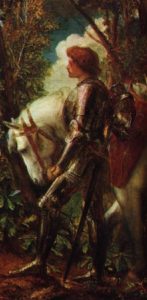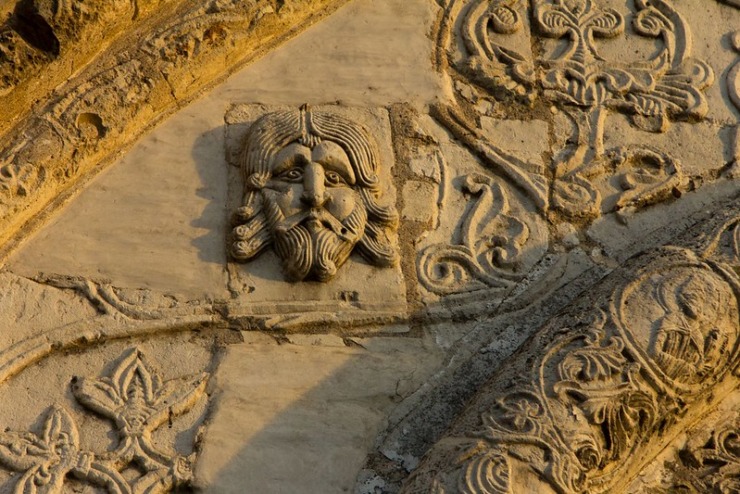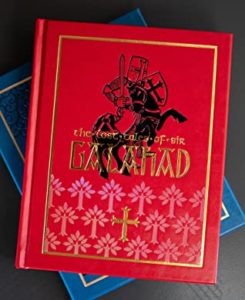A research team discovers what really happened to Sir Galahad
Sir Galahad, son of Sir Lancelot and the Lady Elaine of Corbenic, remains shrouded in the mists of time. We knew he undertook his famous quest to find the holy grail (not to be confused with the winery and vineyard in Missouri) and went roaming in a “wild forest,” but that’s all we knew.
Until now.
A “research team” from the Society for Galahadic Study and Emulation has announced a momentous discovery. In the archives of the Bodleian Library at Oxford, they found (actually, one of their student interns found) a bust of St. Plagiarus of Tintagel (pay attention to the names). Inside the bust was a sheaf of manuscripts of accounts of Sir Galahad after he embarked upon his quest.

Sir Galahad by George Frederic Watts
Reaction by members of the Galahood was electric. The Galahood is the shorthand term for professional Society members as well as lay groups, sometimes referred to as lay groupies. If you are a member of the Galahood, and I am not making this up, you are entitled to be called a Galahoodlum, and perhaps even being authorized to include the designation on your business cards.
Anyway, as I was saying, the Galahood was euphoric, their excitement tempered only by the fact that some of the manuscripts were incomplete and some partially damaged with the vicissitudes of time, mold, insects, and someone’s spilled cup of tea. Nevertheless, what remained in mostly complete condition were some 25 stories. And they’ve now been collected as The Lost Tales of Sir Lancelot, each tale carefully “edited” by a writer and professional member of the Society.
The works, collected in a handsome red volume of real imitation leather, is a marvel of invention and research. This is a work where even the footnotes are not to be overlooked, as they are as informative (translated “entertaining”) as the stories themselves. Accompanying the stories are linocut illustrations by Ned Bustard, who served as editor (along with Jennifer Trafton and Galahadic scholar Gwenifere of Traff Town). Bustard also “edited” two of the stories and editor Trafton (or is that Traff Town?) contributed one.
And what stories these tales tell! In that wild forest (the precise location of which is still debated by Galahoodlums everywhere), Sir Galahad met all kinds of people, animals, mythic creatures, and dangers. A holy friar who was anything but. A riddle game. The oak tree that spoke. The Knight of Unmitigated Calamity.
He was pelted with hazelnuts by a fairy and fell into a bewitched pool. He discovered an angry grove of trees with terrible-tasting apples. Sir Galahad encountered a hiccoughing phoenix (who, eventually, rose from the ashes, still hiccoughing). He got saddle-sore. His meeting with a naiad is “translated” in a wonderful poem by Galahoodlum Malcolm Guite. He became lost in the foggy valley of the white stones, a wonderful story “edited” by Society member Douglas Kaine McKelvey, which turned into quite something else besides a foggy valley. (Kaine should know a lot about horses, which figure in this story, as he has said he’s descended from Scottish horse thieves.)
Editor Trafton (or is that Gwenifere of Traff Town?) has a wonderful introduction, and Pete Peterson covers the acknowledgments (which explain where the volume came from (really)) in addition to writing the final story, “Sir Galahad and the Plumed Knight.”
The book is currently available from The Rabbit Room Press and will be available on Amazon on June 14. I don’t know if the publisher has plans for an ebook version; for a volume like this, the hardback (or real imitation leather) version is the one to hold in your hand as you read.
The Lost Tales of Sir Galahad is no send-up or print version of the 1975 film Monty Python and the Holy Grail. A group of writers (okay, Galahoodlum writers) has written a series of fairy tales, suitable for all ages, around one of the mythic figures associated with King Arthur and the Knights of the Round Table. It’s a wonder of creativity and invention.
And, I confess, it turned me into a Galahoodlum.
Photo by Mari, Creative Commons, via Flickr. Post by Glynn Young.
How to Read a Poem uses images like the mouse, the hive, the switch (from the Billy Collins poem)—to guide readers into new ways of understanding poems. Anthology included.
“I require all our incoming poetry students—in the MFA I direct—to buy and read this book.”
—Jeanetta Calhoun Mish
- Longfellow’s “Paul Revere’s Ride”: Creating a National Legend - April 17, 2025
- Poets and Poems: Katie Kalisz and “Flu Season” - April 15, 2025
- Poets and Poems: Michelle Ortega and “When You Ask Me, Why Paris?” - April 10, 2025



Laura Brown says
What a fun post and what a playful book!
Glynn says
Reading this book was simply plain fun — fairy tales, some tongue-in-cheek, and entertaining footnotes.
Bethany R. says
What a discovery! Well done, student intern! I’m glad you clarified the bit about it not being a Monty Python creation, as that was the first thing that popped into my mind. 😉 Thanks for sharing this!
Glynn says
The editor attempts to circumvent the “reality” that it the intern who spilled the tea and ruined several manuscripts. The name of the intern is not mentioned.
L.L. Barkat says
So… they’ve made up the historical part and the supposed finding, yes?
(Trying to figure what’s fiction here. 🙂 )
Fun project. Fun cover!
Glynn says
That’s part of the fun. Once you read that the research team that did the work on the manuscripts was under the direction of Professor N.I.T. Witte, you know what you have in your hands is a wonderful, if fictional, invention.
Megan Willome says
My husband is a big fan of Ned Bustard’s book “Revealed.” Glad to know about this new one!